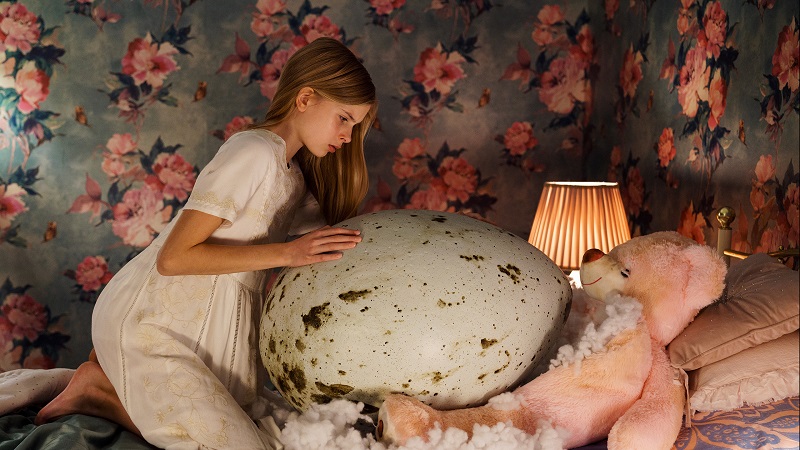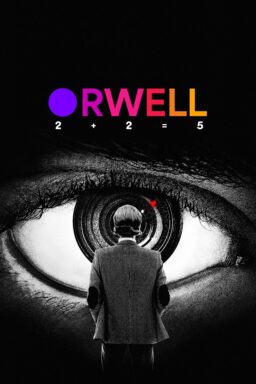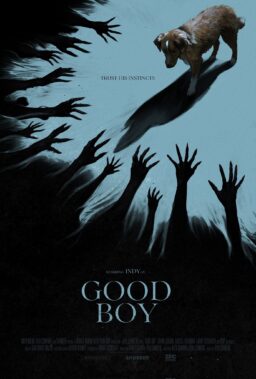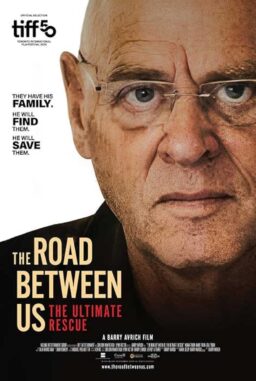In containing its Midnight section to six films for its all-virtual edition this year, the Sundance Film Festival delivered a lineup of hard-hitting genre films that felt consistently programmed with the audience experience in mind.
Pinwheeling between dark comedies and rock documentaries, leaving space for slasher throwbacks and social satires, the Midnights this year were governed by a sense of carefully curated unpredictability. These were movies Park City would have welcomed with nervous excitement, the kinds of pulse-pounding and occasionally stomach-churning late-night selects that would have charged up audiences then sent them buzzing out into the night.
Imagine my surprise, upon taking in the remaining titles in the Midnight lineup, to discover all three were coming-of-age stories: one centering a 12-year-old girl (“Hatching”), another a bullied older teenager (“Piggy”), and the last an entire generation of musicians rising up in an early 2000s New York bound for similarly dramatic upheaval (“Meet Me in the Bathroom”).
The most deliriously imaginative of the three is Hanna Bergholm’s “Hatching,” an endearingly grotesque horror-comedy about the messiness of parenting. As it opens, the film first shows us the filming of a vlog: one of countless uploaded to Lovely Everyday Life, a bottomless feed of domestic bliss that Mother (Sophia Heikkilä) spends each day curating. From the way she poses her daughter, Tinja (Siiri Solalinna), and young son, Matias (Oiva Ollila), opposite their father (Jani Volanen), it’s clear that Mother runs this roost. When she’s not manufacturing all the family’s picture-perfect content, her vision of suburban idyll involves garishly over-decorating the homestead, where roses choke floor-to-ceiling wallpaper and too much glass gleams precariously. It’s artificially whitened everything, as far as the eye can see, enough to make you wonder how anyone can breathe.
Early on, a squawking crow crashes into a window and gets inside, laying waste to all the stemware and the chandelier in its flight path. Tinja manages to catch and present the errant fowl to her mother, who snaps its neck then hands it back to her daughter for composting. Tinja, horrified by this, later returns to the bin and takes the bird into the forest for a proper burial. There, she discovers a solitary egg and takes it home, placing it under and eventually inside a favorite pink teddy bear as it continues to grow at an alarming rate.
When the egg cracks open to reveal a viscid, gangly hatchling—a gloriously revolting puppet, with a hand-crafted look that enhances both the creature’s freakiness and its strange fragility—Tinja takes this thing under her wing, eventually naming it Alli. The pressures of a gymnastics competition and regular intrusions by her nosy little brother make it hard to hide this creature, with whom she discovers a psychic link. All the same, Tinja vows to be a better mother to Alli than Mother has been to her. And the nurturing process proves transformative for Tinja, as she begins to see with increasing clarity the extent of Mother’s narcissism.
Fitting as it might be to describe “Hatching” as a fractured fairy tale, such an assessment wouldn’t quite do justice to the bizarre logic with which Bergholm and writer Ilja Rautsi crack open an influencer-culture satire to reveal the defiantly goopy creature feature inside. Instead of trapping their film between genre polarities, the juxtaposition of these uncanny realities allows “Hatching” to color its central conflicts—of order and chaos, parent and child, nature and nurture, ego and id, external projection and deeper truth—in clever, surprising ways.
That’s before the characters all collide in suitably crunchy fashion. Bergholm stages a showdown between mother, daughter, and creature with grim humor and a sense of inevitability. The film’s anger, before bubbling over there, feels shared between all its female characters in a way that announces “Hatching” most as a movie about the cycles of unhappiness that keep breeding monsters. There’s Mother, unloved and unloving, and Tinja, quietly twice as damaged as a result; and there’s certainly what Tinja births from that egg, which inherits and embodies Tinja’s inner anguish while resisting her control. The twisted, strongly performed dynamics between these actresses—and the continued sight of such an amusingly hideous symbol clawing its way out of the film’s manicured influencer hell—make “Hatching” an unusually satisfying oddity.

Blasting into the Midnight section with an explosive sense of anger is Carlota Pereda’s “Piggy.” Out of all the titles at the virtual fest this year, I’d vote this Spanish grindhouse throwback most likely to burn down the house wherever it plays in-person next. Frequently, I wished I was watching it with a crowd that could have reacted as viscerally as I did to the uncompromising force of its violence, which is by turns distressing and darkly cathartic.
Expanding upon Pereda’s short film of the same name, “Piggy” is set in an isolated Spanish village, where dirt roads and poorly ventilated storefronts offer little reprieve from the oppressive heat of a long summer. Especially unfortunate is the fate of Sara (Laura Galán), a teenager tasked with helping out in her parents’ butcher shop; if the work itself wasn’t grisly enough, the neighborhood mean girls—whose callous nickname for Sara provides the film’s title—tend to congregate outside to post selfies and flirt with men passing through.
Early one morning, Sara slips away from the butcher shop and heads to the local pool, where she hopes to bathe in privacy. No such luck. Finishing his swim, a stranger (Richard Holmes) meets her gaze with a look she can’t quite identify. And before Sara can submerge herself, her tormentors—Maca (Claudia Salas) and Roci (Camille Aguilar), who both delight in the abuse, and Claudia (Irene Ferreiro), who goes along with it—terrorize Sara and almost drown her. Most cruelly, the girls steal her clothes and towel, leaving Sara to walk home in a bikini.
Traumatized by this encounter—and by another that unfolds, just as brutally, when three men accost her on the side of the road—Sara almost doesn’t realize what she’s seeing when she stumbles across her bullies being violently abducted by the stranger from the pool. Having witnessed Sara’s earlier ordeal, the stranger makes eye contact with her, leaving a towel behind as he drives off with a brutalized Claudia visibly pleading for help from the rear window.
Perhaps owing to the shock of this, to her own victimization, to the stranger’s unexpected decency, or to some combination of all three, Sara doesn’t say what she’s seen. Days pass. As villagers search for the missing girls, and their increasingly desperate families attempt to shake the truth out of Sara, her silence becomes freighted with guilt. And especially once other locals turn up dead, the confusion of her own moral compass leads Sara into a dangerous dance with the killer.
“Piggy” opens with sweaty shots of meat being cleaved, drained, and stacked, an ominous prelude to the film’s journey toward a very different kind of slaughterhouse. One wishes that the film could sustain the slow-burn menace of that early section through its inferior middle stretch, which despite an intermittently tense nighttime sequence feels like it’s spinning its wheels. This sensation is compounded by the way its narrative complications often keep Sara on the move instead of more closely scrutinizing the layers of her inner conflict.
What shines through most about Pereda’s direction is her unflinching attention to physicality, the tremendously upsetting but never-quite-exploitative way she keeps exposing Sara and impeding her movements. (In this respect, the film’s Academy ratio is a major asset, constantly working to box her in.) Away from the village in parched landscapes, Pereda’s framings paint Sara as exceptionally alone and vulnerable, but equally uncomfortable is a claustrophobic home life she can never move through unencumbered.
Galán’s intensely anguished performance, eyes wide and body heaving with exhaustion, often feels like it’s running on adrenaline, and the actress captures the profound fear and psychological retreat of someone who believes they might spend their life trapped. The film’s most harrowing sequences depict Sara’s ordeal, largely implying the ones that then befall her tormentors. Galán’s work justifies this focus while enabling “Piggy” to depict the bloodbath of the film’s third act in ways that are morally twisted but—through their continued centering of Sara’s coming-of-age story—undeniably triumphant.

This critic’s final Midnight screening of Sundance was Dylan Southern and Will Lovelace’s “Meet Me in the Bathroom,” a euphoric and romanticized ode to the rock ‘n’ roll renaissance of early 2000s New York, back when bands like The Strokes, Yeah Yeah Yeahs, Interpol, and LCD Soundsystem had the city’s music scene rigged to blow.
It wasn’t all that long ago. But the new film, inspired by music journalist Lizzy Goodman’s 2017 oral history of the same name, isn’t out to objectively examine the era so much as relive it, one blurry night at a time. Before all the stifling self-documentation of smartphones and social media, this community’s pursuit of youth and abandon was more urgent and frenetic, about presence in the moment and spending every night on the edge; post-9/11, the promise it could all be ripped away in an instant only encouraged them to burn as brightly as they could.
A veteran of the scene herself, Goodman’s masterstroke with the book was to sit readers down at a booth at the back with that era’s most iconic figures, so they could tell you themselves what happened. “We were all chasing New York City,” she wrote in its introduction. “And for a few magical years, we caught it.” That kind of you-are-there electricity was singular, but in an effort to channel it Lovelace and Southern have pieced their documentary together from a treasure trove of archival footage and audio. Blasting through concert clips, home movies, and contemporaneous interviews, the filmmakers zero in on as many capital-M moments as they can—The Strokes’ rapid ascension and first UK tour, Karen O unleashing her inner banshee on stage, the arrival of LCD Soundsystem’s James Murphy—without filling in all the details that surrounded them. The result is a warm but hazy guided tour of a scene as it’s most vividly remembered, rather than how it was.
For those already enamored of the period, “Meet Me In the Bathroom” will prove irresistible. It helps that none of its buzz bands have ever needed an introduction to electrify an audience. (They certainly didn’t back then.) Footage of Karen O and Julian Casablancas getting up on stage at their local dives is imbued with such raw vitality—and additionally charged with our knowledge that it’s history in the making—that it will make converts of those coming in fresh.
Yet this is a film for the nostalgic, not neophytes, and it reminisces about more than just the music. New Yorkers will be especially taken with the mythic portrait of their city, where potential crackled in the air and young artists pilgrimaged to find out who they were. This frame does better by the scene’s four most legendary bands than the others that existed around them. Though the Moldy Peaches show up in the film’s early going, its brief inclusion of acts like The Rapture, TV on the Radio, and Liars feels like an afterthought especially, given all the imperfect parallels created by a 108-minute documentary that’s still trying to cover far too much ground.
Of particular note is the documentary’s depiction of 9/11, which arrives on screen just as it did in real life: abruptly, chaotically, and with an instantly sobering gravity. Only in hindsight was it possible for anyone to register that they had been living in the calm before a storm, and the film reckons with that reckoning by documenting the toll it all took on musicians like Interpol’s Paul Banks, who made his way through the ashes of the World Trade Center, and Kimya Dawson, who wrote the soul-sick “Anthrax” in the attack’s aftermath.
Goodman’s book covered an entire decade, from 2001 to 2011, whereas Lovelace and Southern limit their film’s scope to the first few years of the 2000s. This omits a great many musicians but has the welcome effect of elevating Karen O and Casablancas into the film’s protagonists. Their signature songs even mark its emotional highs.
Both musicians also get refreshingly honest about the mixed emotions they felt back in the day, Casablancas’ coolly detached demeanor masked his anxiety at the band’s massive success. O, meanwhile, came into her power in a scene that often took more from her than she wanted to give. There were tensions and controversies that the documentary seems to wave away, and “Meet Me in the Bathroom” has an oddly sanitized view of a scene in which everyone was high on way more than just a shared creative impulse. What everyone remembers most clearly, or at least wants to canonize, are memories of the friends they made along the way. To hear them tell it, those really were golden days: a wild communal coming-of-age rager that the music harnessed then amplified out for a generation to share.












